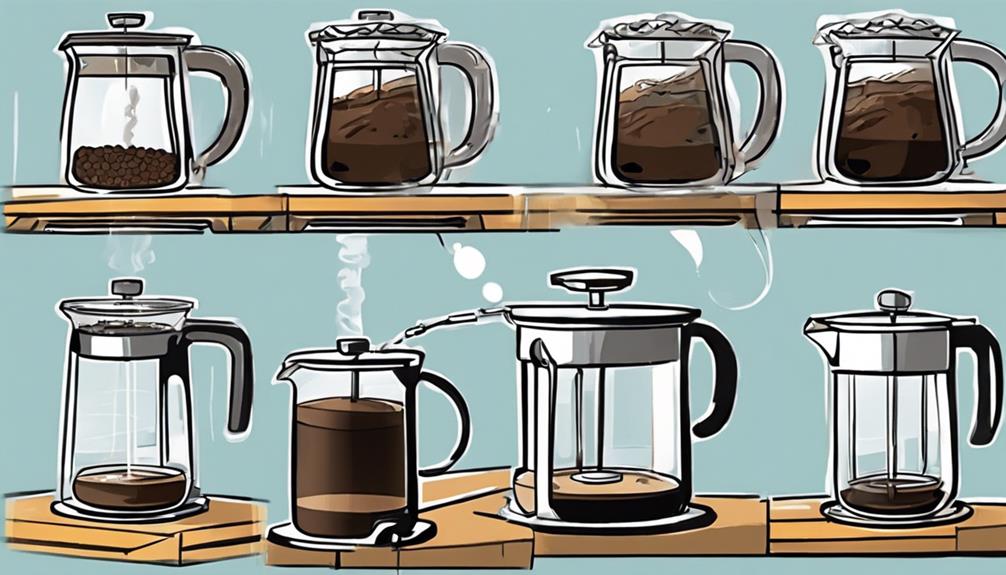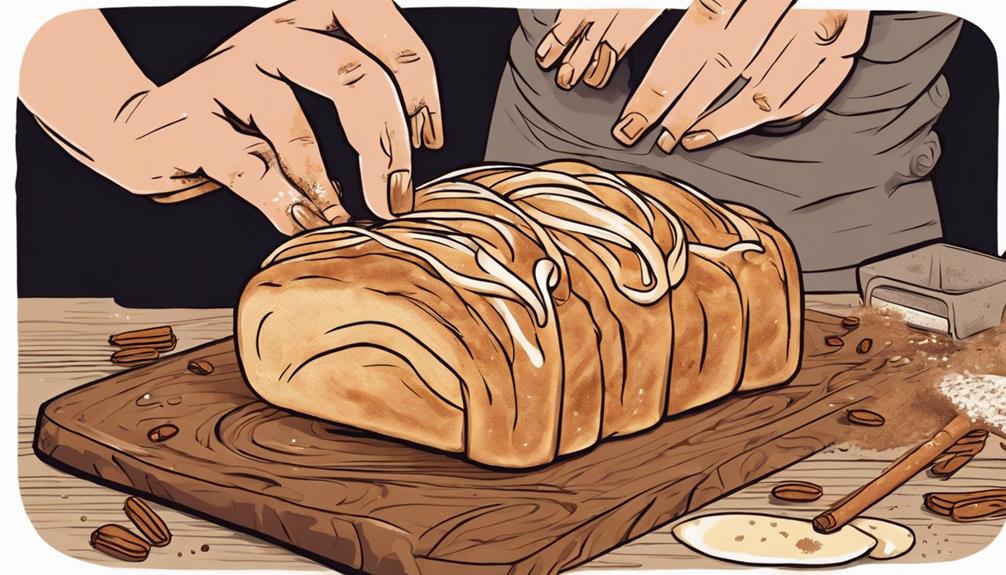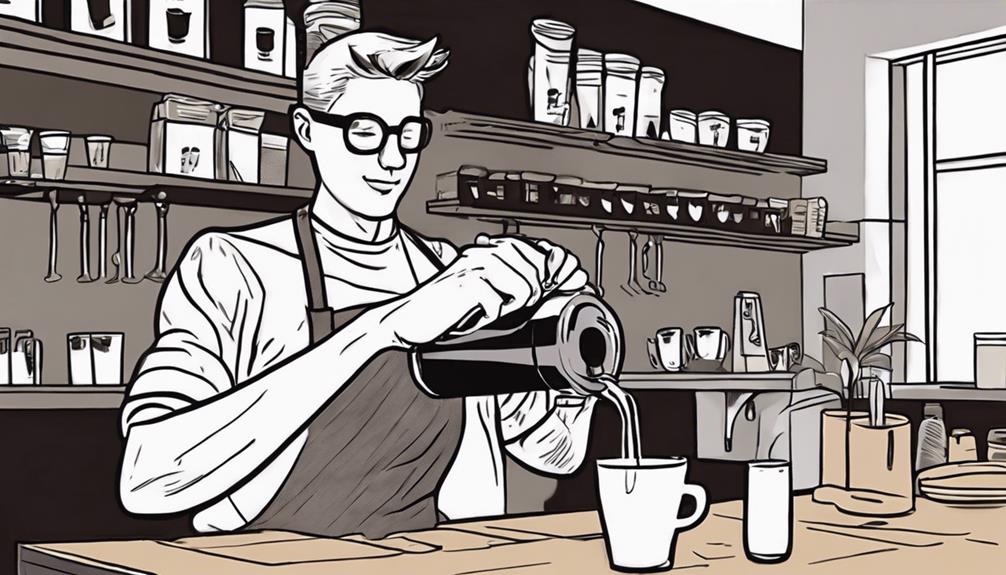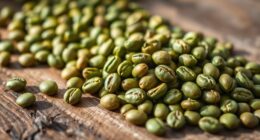Prepare your French press effortlessly by cleaning the carafe, inserting the mesh filter, spiral plate, and tightening it. These easy steps will result in a fantastic cup of coffee. Embrace the process and…
Key Takeaways
- Rinse glass carafe with water before assembly.
- Place mesh filter screen on the cross plate.
- Add spiral plate and tighten components.
- Ensure correct assembly for delicious coffee.
- Follow simple steps for a perfect cup.
French Press Parts Overview
The essential components of a Bodum French Press include the glass carafe, cross plate, mesh filter screen, spiral plate, and lid with plunger.
When it comes to French presses, understanding the purpose of each part is key to mastering the art of brewing delicious coffee.
The glass carafe, where the magic happens, holds the coffee grounds and hot water.
The cross plate serves as a base for the mesh filter screen, preventing grounds from escaping into your brew.
The mesh filter screen strains the coffee, ensuring a smooth and rich texture.
The spiral plate adds pressure when plunging, extracting maximum flavor from the grounds.
Finally, the lid with plunger seals the deal, allowing you to press down the grounds once the brewing process is complete.
Familiarizing yourself with these French press parts won't only streamline the assembly process but also enhance your coffee-making experience.
Assembling a Bodum French Press
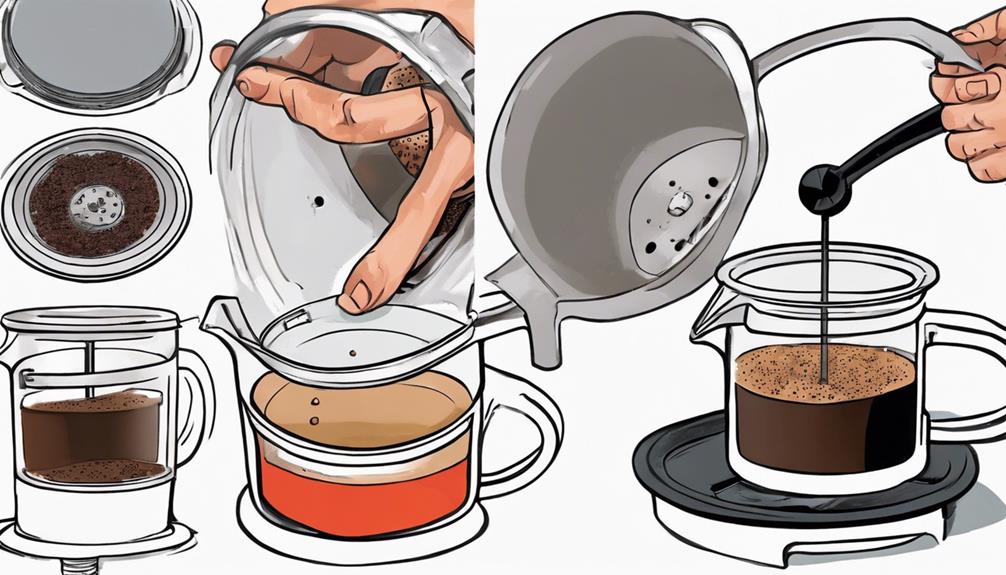
To gather a Bodum French Press, start by rinsing the glass carafe with water. This step guarantees that the carafe is clean and ready for brewing.
Next, place the mesh filter screen on top of the cross plate, followed by the spiral plate. Make sure that the components fit snugly together.
Then, tighten the connecting piece at the bottom of the cross plate to secure all the parts in place. It's essential to align and tighten all components properly to prevent any leaks during brewing.
Once everything is assembled correctly, your Bodum French Press is ready to brew delicious coffee. Enjoy the rich and flavorful coffee that this French Press can provide.
Following these simple steps will guarantee that your Bodum French Press is set up correctly and ready to use whenever you need a perfect cup of coffee.
French Press Maintenance Tips

To maintain your French press in top condition, remember to clean all parts thoroughly after each use to prevent residue buildup.
Check for loose or missing components periodically to guarantee everything functions properly.
And don't forget to store your French press in a dry place to avoid rust and prolong its lifespan.
Cleaning Procedures
Regularly maintaining your French press by cleaning it after each use is essential to prevent residue buildup and achieve peak performance.
To begin the cleaning process, carefully disassemble your French press, separating the plunger, filter, and glass carafe. Wash each component thoroughly with warm, soapy water, making sure to eliminate any coffee grounds or oils that may have accumulated. Rinse all parts well to guarantee no soap residue remains.
After cleaning, dry all components completely before reassembling the French press. Ensure that the plunger is properly aligned, and the filter is securely in place to avoid any leaks during use.
Store your French press in a dry location to prevent rust and mold growth. Remember to regularly replace the filters to maintain optimal performance and achieve the best possible coffee taste.
Part Replacement Guidelines
When maintaining your French press, it's important to replace specific parts periodically to ensure peak performance and longevity.
Here are some guidelines for part replacement to maintain your French Press is in top condition:
- Mesh Filter Screens: Replace every 3-6 months to sustain peak performance.
- Glass Carafe: Check for cracks or chips, and replace if any damage is found to avoid breakage during use.
- Plunger: Ensure smooth functionality; if it becomes stiff or loose, consider replacing it for a superior brewing experience.
- Spiral Plate: Replace if showing signs of wear or rust to prevent affecting the taste of your coffee.
Storage Recommendations
Storing your French press properly is vital for maintaining its quality and durability over time. To safeguard your French Press stays in top condition, store it in a dry place to prevent rust and corrosion.
Avoid areas with high moisture levels, as this can harm the metal components. Keep the French press away from direct sunlight to preserve its appearance and functionality.
When not in use, store the French press with the plunger in the up position to prevent any damage to the filter. Additionally, consider using a protective case or bag when storing or transporting the French press to prevent any accidental bumps or scratches.
Troubleshooting Common French Press Issues
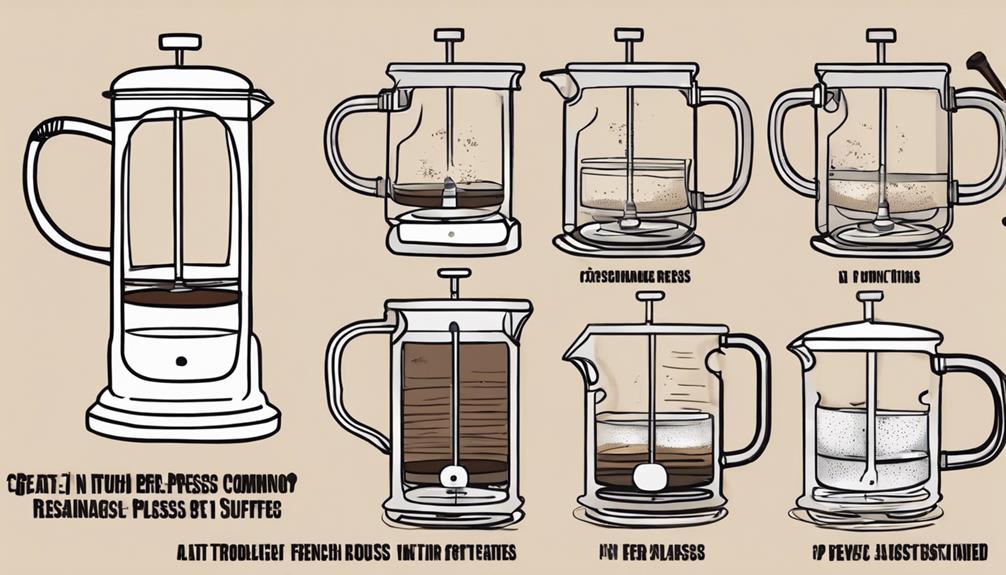
If your French press plunger is stuck, dismantle the unit for a thorough cleaning to clear any blockages.
Inspect the glass carafe for cracks that could disrupt brewing or cause leaks.
Make sure all components are correctly aligned and tightened to prevent operational issues.
Stuck Plunger Solutions
To resolve a stuck plunger issue with your French press coffee maker, first disassemble the unit and thoroughly clean all components.
Here are some steps to help you troubleshoot the problem:
- Check for Obstructions: Inspect the mesh filter and the sides of the glass carafe for any coffee grounds or sediment that may be causing the plunger to get stuck.
- Confirm Proper Alignment: Make sure that the filter screen is correctly positioned within the plunger assembly and that the plunger rod is straight to avoid any misalignment issues.
- Tighten Components: Verify all parts, including the filter, plunger rod, and lid, are securely tightened to prevent any wobbling or misalignment that could lead to a stuck plunger.
- Plunge with Care: When plunging, apply gentle and even pressure to avoid jamming the plunger. Excessive force can cause the plunger to get stuck further.
If these steps don't resolve the issue, consider reaching out to customer support for further assistance or replacement parts.
Glass Carafe Inspection
Inspect the glass pitcher of your French press coffee maker for any cracks, chips, or misalignment that could impact the brewing process. A damaged glass pitcher can lead to leaks or uneven brewing, affecting the quality of your coffee. Make sure to carefully examine the pitcher for any signs of wear or damage on its surface. Additionally, verify that the glass pitcher is securely placed within the French press assembly to prevent any accidents during use.
Checking the glass pitcher for proper alignment with the other parts is essential to avoid any issues while brewing your coffee. Misalignment can cause difficulties in plunging and may result in spills.
It's also important to keep the glass pitcher clean and free of any residue that could alter the taste of your coffee. By maintaining the integrity of the glass pitcher, you can enjoy consistently delicious French press coffee.
Proper Part Alignment
Ensuring proper alignment of all components in your French press coffee maker is important for a seamless brewing experience without any possible issues. To achieve this, follow these essential steps:
- Center the Mesh Filter Screen: Make sure the mesh filter screen is positioned precisely in the middle of the cross plate. This alignment prevents coffee grounds from escaping into your brew.
- Secure the Spiral Plate: Check that the spiral plate sits firmly on top of the filter screen. This secure placement is crucial for maintaining the necessary pressure during the brewing process.
- Verify Overall Alignment: Confirm that all parts, including the cross plate and plunger, are correctly aligned. This step helps prevent leaks and ensures smooth operation of your French press.
- Tighten the Connecting Piece: Keep all components securely in place by tightening the connecting piece at the bottom of the cross plate. This action enhances stability during brewing, avoiding any possible issues.
Enhancing Your Coffee Experience
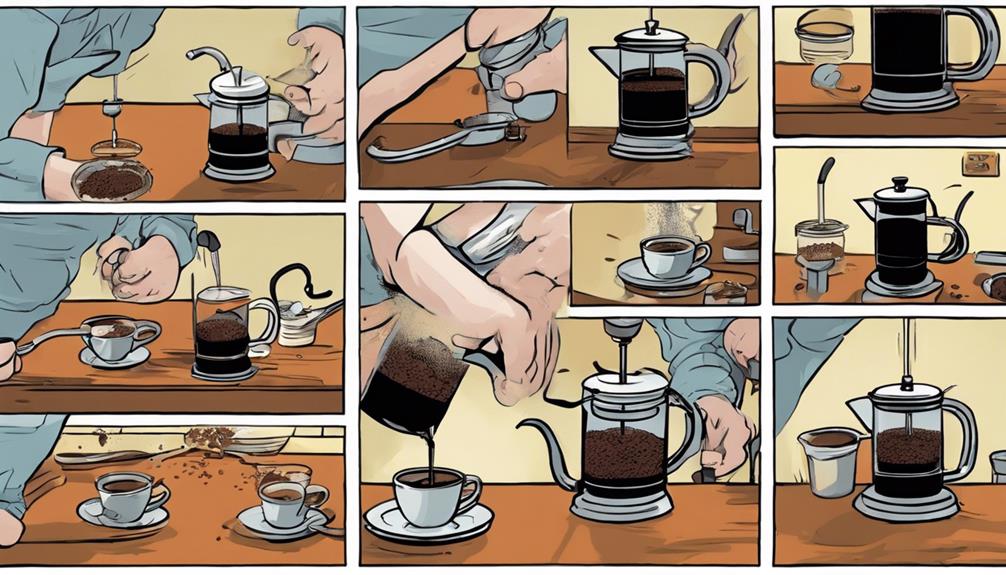
Improve your coffee experience by experimenting with different brewing times to adjust the strength and flavor of your French press coffee.
To start, preheat the glass carafe with hot water before brewing to maintain the ideal temperature for extraction.
When it comes to the coffee beans, choose coarse grounds to achieve a fuller-bodied brew while preventing excessive extraction.
Remember to stir the grounds gently after adding hot water to ensure uniform extraction throughout the brewing process.
With a French press, you have the freedom to control the flavor and strength of your coffee unlike any other brewing method.
Take advantage of this unique feature by varying your brewing times to find the perfect balance that suits your taste preferences.
Benefits of French Press Coffee
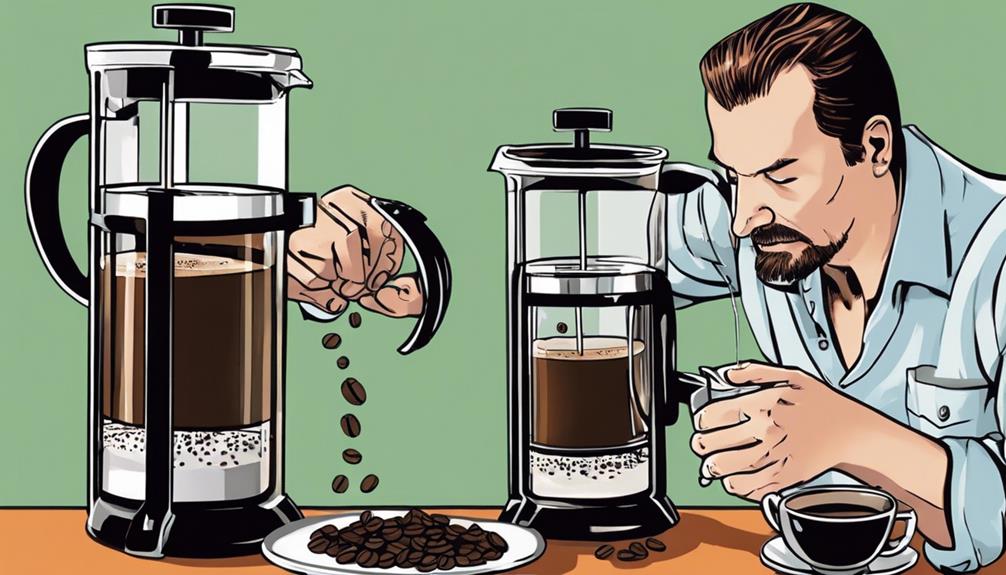
French press coffee delivers a full-bodied flavor and rich taste that sets it apart from other brewing methods. When you opt for French press coffee, you're in for a treat.
Here are some benefits you can enjoy:
- Full-Bodied Flavor: The direct immersion brewing method of the French press allows the coffee grounds to steep fully, resulting in a robust and full-bodied flavor profile.
- Control over Brewing Process: With a French press, you have the freedom to control various brewing variables like water temperature, steeping time, and coffee grind, giving you a personalized coffee experience.
- Enhanced Natural Oils and Flavors: Since French press coffee doesn't use paper filters, the natural oils and flavors of the coffee beans are preserved, leading to a more aromatic and flavorful cup.
- Robust Body and Depth of Flavor: Coffee enthusiasts appreciate French press coffee for its intense and deep flavor profile, making each sip a delight for the taste buds.
Indulge in the rich and satisfying experience of French press coffee for a truly exceptional cup of joe.
Tips for Making French Press Coffee

For best outcomes when making French press coffee, remember to use coarsely ground coffee beans to prevent excessive extraction. Coarse grounds are ideal as they allow for a slower extraction process, resulting in a well-balanced and flavorful brew.
To enhance the flavor extraction further, let the coffee grounds bloom for 30 seconds after adding a small amount of hot water. This blooming process allows the coffee to degas and leads to a more aromatic cup.
Once you add the remaining hot water, gently stir the grounds to make sure they're evenly saturated, promoting consistent extraction.
Experimenting with different brewing times can help you tailor the strength and flavor of your French press coffee to your liking. Additionally, preheating your French press with hot water before brewing helps maintain the best temperature for extraction.
French Press Cleaning Guide
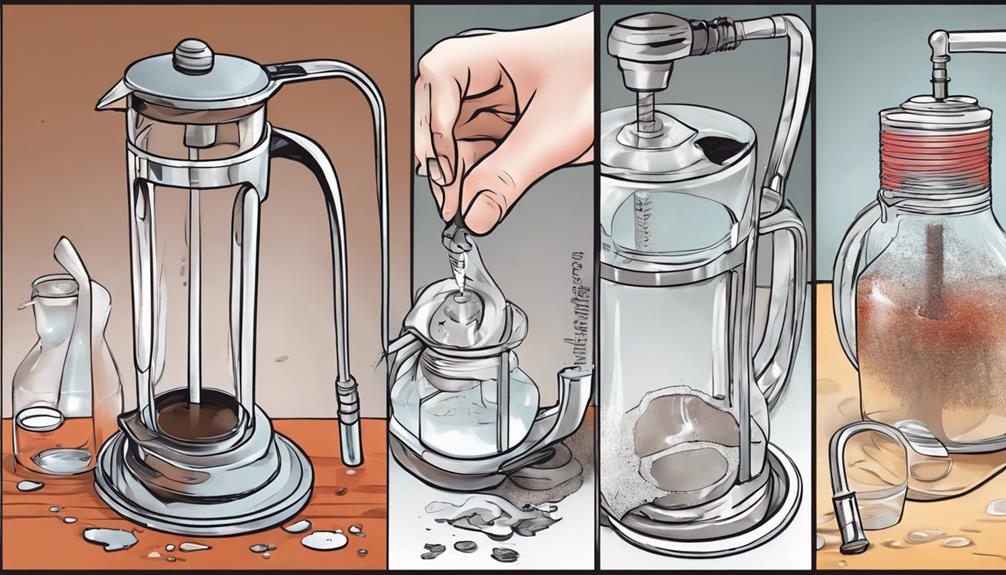
When it comes to maintaining your French press, daily cleaning is key to remove grounds and particles.
Additionally, a weekly deep cleaning using a baking soda paste and vinegar soak helps keep your French press in top condition.
Remember to thoroughly dry all components after cleaning to prevent rust and preserve the quality of your coffee maker.
Daily Cleaning Routine
Consider incorporating a baking soda paste and vinegar soak into your weekly routine to maintain the cleanliness of your French press.
For your daily cleaning routine, follow these steps:
- Use Gentle Dish Detergent:
Wash your French press with a mild liquid dish soap and warm water to effectively remove grounds and particles each day.
- Thorough Drying:
After cleaning, verify all parts of your French press are fully dried to prevent mold and bacteria growth.
- Regular Maintenance:
Implementing a daily cleaning routine will help preserve the quality of your French press and guarantee a fresh coffee taste with every use.
- Extend Lifespan:
Consistent cleaning not only enhances your coffee brewing experience but also prolongs the lifespan of your French press.
Weekly Deep Cleaning
To uphold the cleanliness and freshness of your French press, incorporate a weekly deep cleaning routine using a baking soda paste and vinegar soak for thorough removal of stains and residue.
Begin by disassembling your French press and creating a paste using baking soda and water. Apply this paste to the inside of the press, focusing on areas with stubborn stains. Let it sit for a few minutes before scrubbing with a brush to make certain all residue is removed.
Next, soak all the parts in vinegar for about 10-15 minutes to further break down any remaining stains. After soaking, scrub each component with a brush to ensure a deep clean.
Rinse thoroughly with water and dry all parts completely before reassembling your French press. Regular weekly deep cleaning not only keeps your French press looking pristine but also helps maintain the quality and taste of your coffee.
Importance of Drying
Why is thorough drying of all components important after cleaning your French press? Proper drying is vital for maintaining the quality and longevity of your French press.
Here's why:
- Prevent Mold and Bacteria Growth: Drying all parts thoroughly after cleaning helps prevent the buildup of mold and bacteria, guaranteeing a safe brewing experience.
- Prevent Rust and Deterioration: Proper drying ensures that the components don't rust or deteriorate over time, preserving the French press's functionality and appearance.
- Maintain Flavor Integrity: Moisture left in the French press can affect the flavor of future brews. Thorough drying helps preserve the purity and taste of your coffee.
- Ensure Longevity: Air drying is the best method for guaranteeing all parts are completely dry before reassembly. Storing the French press in a dry place after cleaning and drying further extends its lifespan.
Coffee Brewing Methods Comparison
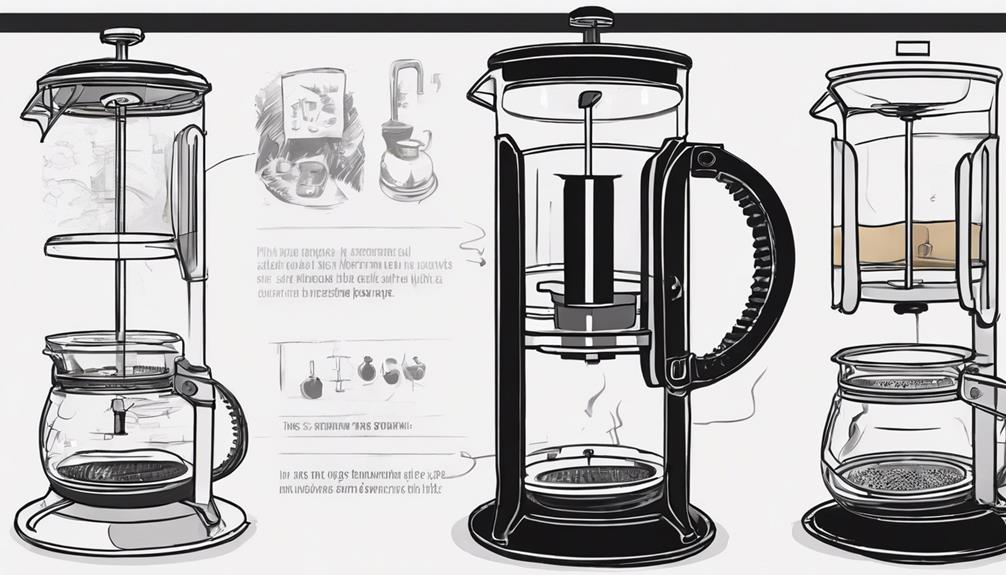
Comparing different coffee brewing methods reveals the unique characteristics and flavor profiles each method offers. When it comes to French press brewing, the process involves steeping coffee grounds in hot water before pressing them through a filter. This method results in a fuller body and richer flavor profile compared to drip coffee.
French press brewing also provides control over extraction time and coffee strength, allowing for a customized experience.
Coffee enthusiasts often favor the French press for its simplicity and ability to highlight the natural flavors of coffee. In comparison to other methods like pour-over or espresso, the French press stands out for its ease of use and versatility.
While pour-over brewing may offer a cleaner taste and espresso a more concentrated flavor, the French press remains a popular choice for those seeking a straightforward yet flavorful coffee experience.
Best French Press Coffee Makers
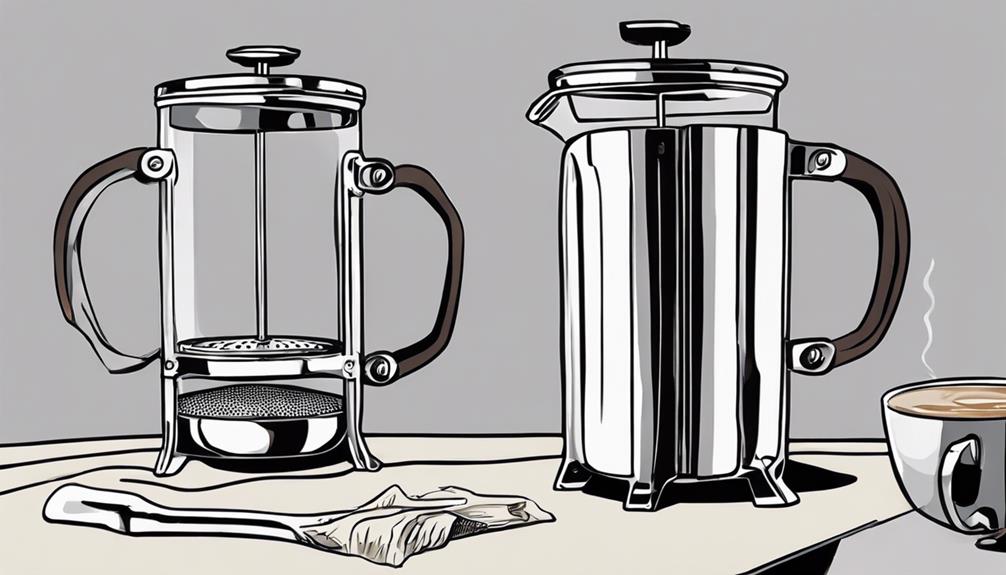
When selecting the finest French press coffee maker, consider the available sizes and materials for the best brewing experience.
Here are some key points to keep in mind when choosing the best French press coffee maker:
- Size Options: French press coffee makers come in various sizes, catering to single-serving needs or larger capacities for multiple cups.
- Material Quality: Opt for models made from high-quality materials like stainless steel or durable borosilicate glass for long-lasting use.
- Brewing Control: Enjoy the flexibility of controlling brewing time, water temperature, and coffee-to-water ratio with French press coffee makers.
- Features to Look For: Look out for features such as a reliable plunger mechanism, easy assembly, and dishwasher-safe components to enhance your coffee brewing experience.
Investing in one of the best French press coffee makers can truly elevate your coffee game, providing you with rich, flavorful results every time.
Frequently Asked Questions
How to Put a French Press Coffee Maker Together?
To put a French press coffee maker together, start by placing the base on a flat surface. Add the mesh filter screen and secure the spiral plate. Confirm everything fits before tightening. Your French press is now ready for brewing!
How Do You Assemble French Press Parts?
To assemble French press parts, place the base on a flat surface, insert the mesh filter screen, add the spiral plate, and secure all parts tightly. Your French press is now ready for brewing your favorite coffee with ease! When assembling a coffee press, it’s important to ensure that each part is securely in place to avoid any leaks during the brewing process. Once all the parts are assembled, add your ground coffee and hot water, then press the plunger down slowly to filter out the grounds. Assembling a coffee press is a simple and efficient way to enjoy a fresh and flavorful cup of coffee. Attaching a coffee maker to your French press is another convenient option for those who prefer a quicker brewing process. By simply adding the coffee maker attachment to the top of your press, you can easily brew your coffee directly into a travel mug or carafe. This versatile feature makes assembling and using a French press even more efficient and appealing to coffee lovers.
What Are the Parts of a French Press?
To assemble a French press, you need a glass carafe, cross plate, mesh filter screen, spiral plate, and lid with plunger. Did you know that French press coffee makers originated in France in the late 1800s?
How to Take Apart a Bodum French Press?
To take apart a Bodum French Press, unscrew the connecting piece at the bottom, carefully separate the plunger assembly from the carafe, and remove the spiral plate, mesh filter screen, and cross plate for cleaning.
Conclusion
Now that you know how to assemble and maintain your French press coffee maker, you're ready to brew the perfect cup of coffee every time!
Did you know that the French press method is one of the most environmentally friendly ways to make coffee, producing minimal waste compared to other brewing methods?
So not only will you enjoy a delicious cup of joe, but you'll also feel good about reducing your carbon footprint.
Cheers to great coffee and a cleaner planet!
